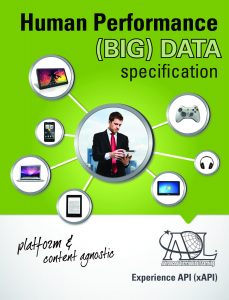
I recently put together a brief explainer for those unfamiliar with the concept of API’s in general and the xAPI in particular, prompted by a great question from Sam Rogers. I thought it might be helpful to share this here.
API simply stands for Application Programming Interface, a software intermediary layer that allows two applications to talk to each other. Each time you use the mobile app for LinkedIn, send an instant message, or check a stock price on your phone, you’re using an API.
When a company offers an API, this simply means they’ve built a set of dedicated web-links (URLs) that return pure data responses . This pure data can be used by another application for a range of purposes.
In 2010, Advanced Distributed Learning (ADL), the governing body for a much older e-Learning standard called SCORM, put out a call for a contractor to write a next-generation e-learning standard. Their goal was to provide a flexible way of recording learning-related activity taking place using a range of devices outside the restrictions of standard learning management systems, which primarily track progress through formalised learning activities.
Rustici Software was awarded the work, which began under the code name Tin Can. By August of 2012, version .95 of the Tin Can API was finalised. In April 2013 ADL coined the official name for the Tin Can API: the Experience API, or xAPI.

The specification for the Experience API (xAPI) achieved ADL’s ambitions and this now allows learning related content and learning systems to speak to each other, recording and tracking types of learning related activity not tracked in a conventional Learning Management System (LMS’s).
For example you could track data arising from micro-behaviours and conditions such as:
- Reading an article
- Watching a training video, stopping and starting it
- Training data from a simulation
- Performance in a mobile app
- Chatting with a mentor
- Physiological measures, such as heart-rate data
- Micro-interactions with e-learning content
- Team performance in a multi-player serious game
- Quiz scores and answer history by question
- Real-world performance in an operational context
xAPI helps us answer interesting questions like:
- What learning or work related resources are people accessing?
- What answers are people getting wrong?
- What time of day or night are people accessing learning?
The launch of the xAPI specification in turn spawned a plethora of what are now termed Learning Experience Platforms (LxP’s) Not only that – traditional LMS vendors have responded defensively to bolt Learning Experience-like solutions onto their own offerings.
As Josh Bersin points out in this useful article: “People no longer search course catalogs for ‘courses’ the way the used to, and we need a way to train and learn ‘in the flow of work.'”
However, measuring learning activity is not the same thing as measuring learning itself, nor the measurement of learning impact on business outcomes.
In medical terms most interactions tracked via the xAPI are symptoms suggesting that learning may well be taking place.
By contrast the LMS monitors the pulse and blood pressure in the pulmonary system as formal learning experiences are pumped around the cells in the corporate body.
However we still need to measure the resulting shifts in performance as the organisation competes with other corporate athletes for new opportunities and markets.
Shifts in behaviour may be indicated by current LXP’s but the hard data analytics that prove the desired business impact has occurred currently need to come from other enterprise systems. The next step is to extend xAPI into those enterprise systems so these are more closely integrated into the flow of work.
To review the full technical spec for xAPI please click here.